
History of Sikkim
The very word Sikkim is the corrupt of Shing-khyim in Sikkimese Bhutia (Lhopo) for 'wooden house' as all the Bhutia dwellings are made up of stone and wood. The Sikkimese would also prefer to call this valley as Bayul Dre-Mo-Dzong (meaning hidden valley of sacred treasures of Mahaguru Padmasambhava, reverently known as Guru Rinpoche.
Some scholars also endorse the view that Sikkim is the corruption of Che-khyim meaning 'stone masonry' in Sikkimese. While at the same time, most scholars in Western Sikkim argue that it was Srid-khyim for political-power house i.e., signifying the magnificent Rabdentse Palace, which was one of the earliest capitals of Sikkim.
For the Lepchas, it is their Nye-Mayelyang or the sacred land of hidden paradise or the delightful abode, as this snow-clad land blessed by the gods, and the evergreen lush valleys watered by the two sacred rivers of Tista (Tashi-Drag) and Rangit (Re-Nye), is indeed a land of eternal delight and infinite bliss, a true replica of heaven on earth.
Carefully, the Sikkimese history can be demarcated into three different phases corresponding to the Buddhist era of Tempo Ngadar-Bardar-Chidar (the three phases related to the institutionalization of dharma), and in turn corresponding to the Gregorian periods as below:
- The Early phase: up till 13th century A.D.
- The Medieval phase: 13th to 17th century A.D.
- The Modern phase: 17th century A.D. and onwards.
The Early phase dates pre-eighth century A.D, but pre-dominantly revolves around the great Indian Saint Mahaguru Padmasambhava's visit to Sikkim enroute to Tibet, and the works of different sacred Treasure Revealers (Terton). The Medieval phase begins with the establishment of the blood-brotherhood between the Bhutias (Lhopo) and the Lepchas (Rongs) into a single entity and consolidation of Sikkim as a kingdom. The Modern phase saw the culmination and acknowledgement of different tribal groups under the central leadership of the Denjong Chogyals, the dharma rulers of Sikkim since 1642 A.D.
In several prophecies and apocalyptical books of the Bodhisattva of Compassion, Avalokiteshawara and the Lotus Born Buddha, Mahaguru Padmasambhava, popularly known as 'Guru-Rinpoche', several hidden countries have been mentioned. Of these, the Guru's Bayul-Dre-Mo-Dzong i.e., Sikkim is considered to be the epicenter and mother of all. The other sacred hidden lands are located in parts of Tibet, Nepal and Bhutan. Furthermore, according to Terton Ratnalingpa's guide book, Sikkim is recognized as the highest of all the sacred places of pilgrimage and practice, which is visited and blessed since time immemorial by great Buddhas and Bodhisattavas like Avalokiteshawara (Chenrezi) himself, Jetsun Dolma (Tara) Dro-Nger-Chen, the celestial king Indra, Chogyal Song-Chen Gompo, the incarnated Devis (goddesses), and finally the Khen-Lob-Cho-sum i.e., the Mahaguru Padmasambhava, Santarakshita and Chogyal Tri-song-Dechen followed by their retinue of several dakinis, devas, dharmapalas, tutelary deities, etc. They filled, blessed and sowed all kinds of virtuous seeds and deeds in it and hid their sacred treasures and appointed their protectors and keepers. The guidebook further says that anyone who practices in this blessed land would achieve instant sacred accomplishment. Every cliff, peak, cave, hill and lake of this land is sacred and consecrated.
In another guidebook, Thangyig Shel-Dra-Ma, Sikkim, the Bayul-Dre-Mo-Dzong has been mentioned as the most appropriate place of devotion wherein the Dakinis would appear without being invoked. According to the Neyig, guidebook to all the sacred locations of Sikkim, the Bayul-Dre-Mo-Dzong has five great provinces and six hidden spots that protect all living beings. When Mahaguru Padmasambhava visited this country in the 8th Century A.D. and converted the Dzonga as the keeper of Sikkim, He concealed several sacred scriptures-texts, sacred objects and wealth. He equated this land as sacred as his own Copper-plated-abode (Zangdopalri). On his visit to Sikkim, he turned the Great Khangchendzonga as the supreme protector of this land, who would be responsible for protecting the dharma, environment, people and the land itself of Sikkim as a whole. Later in the late 13 th century A.D., Sikkim was visited by Tertons (revealers of sacred treasures) like Rigdzin Goedemchen and Kathog Ued Yeshe Bumpa, who established meditation centers and Lhakhangs (monasteries) at sacred centers of Drakar Tashiding and Pawo Hungri. It was here that at the sacred cave of Lhari-Nyingphu, Terton Ngari Rigdzin Chenpo Lagdendorjee discovered Khado-Khalangma Tantra.
Terton Ratnalingpa in his guidebook has further said that every cliff, cave, ridge, hilltop and river of Sikkim has been blessed and consecrated and thus, one with pure devotion and correct practice would surely attain spiritual perfection within no time. The book further says that the Bayul-Dre-Mo-Dzong houses a number of objects, both material and sacred like the wish-granting gem of king Indra Bodhi, precious and 500 rare wish-fulfilling gems, enormous sacred texts, miraculous Vajra (dragger) having the power of subduing all the negativities, etc.
An important treasure-revealer Rigdzin-Goedemchen received images of Guru Dragpo and others at the summit of the Mt. Khangchendzonga and subsequently spent a long period in meditation and practice there. The great Rigdzin Chenpo founded a monastery on the Northern pass at Pau-Hung-hri in the 13 th century, the first ever monastery of Sikkim and attained nirvana at the nearby Sinon.
Simultaneously, the very significant guidebook of Rigdzin Godemchen mentions that the Bayul-Dre-Mo-Dzong will be filled with monasteries, retreat centers, hermitages and numerous places of pilgrimage and sanctity … there would be 1,00,000 dwellings, 1,000 monasteries …. Etc. The guidebook Thengo Terchyung talks about five persons possessing spiritual and miraculous powers. These persons are of course the four holy brothers of the historic ' Naljoir Choe-Jhi ' while the fifth one is non-other than the great siddhic master Thikung Mensalong, an-emanation of the Guru Rinpoche himself as the Sikkimese would believe, who was waiting for the occurrence of this auspicious 'Naljoir-Chey-Jhi' event for more than 300-years (as predicted by Guru Rinpoche), in the later 16 th century A.D. at Dzongri in the present day West Sikkim. He introduced the foremost lama, Gyalwa Lhatsun Chenpo of the Naljoir-Chey-Jhi brothers, physically to the different sacred sites in the present western region of Sikkim, after the lama was miraculously identified and recognized by the host master in 1640.
Some of the most important sacred sites mentioned are the four holy caves, four holy lakes, Dzonga-Tagtse, Drakar Tashiding (of the fabled sacred Tashiding Bumchu), etc. The sacred sites are described in codified language in the Neyig, guidebook to all the sacred locations of Sikkim as Bayul-Dre-Mo-Dzong, received in His sacred vision by the great Gyalwa Lhatsun Chenpo himself, who was also the exponent of dzogchen tradition, before his actual advent to Sikkim, in the 16 th Century A.D.
In his guidebook, Terton Sherab Mebar has also mentioned Sikkim to be the most sacred and sanctified equaling it as pure land of Arhats with Dzod-nga Taktse like the abode seated on his throne.
Another Terton Dorjelingpa mentioned the hidden Demajong (Sikkim) situated in the south-west of the Samye Monastery, bounded by Trumo Khangchung in the east, Aryabhumi India in the South, Zargi-Da-men in the west and De-Nga-De-Chung in the north. These form the four cardinal points. Further, there are middle passes viz., Eastern pass Pula-Deng-Tsig, Bangma-Chyangting (southern) Gela-Menzang (western) and Tongpen-Munag (northern). Similarly, there are four sacred gates namely Thola Dong-je (East) Rongjyang Dagtse (south), Yahmar Tagtse in the west and the Dzonga-Tagtse in the north.
Thus the era upto the 13 th century sees Sikkim being prepared groomed and initiated to receive the full teaching and its florishment of the Vajrayana Buddhism of Mahaguru Padmasambhava.
Blood Brotherhood between the Bhutia and the Lepchas as a single entity (Denjong Lhomen Nadam)
The Namgyal dynasty that ruled Sikkim for about 650 years traces its origin to the Minyag Andong House, one of the eighteen quasi-nobilities seized by China, were the descendents of the great Chogyal Trisong-Dechen of Tibet. The 25th King of this Minyag Andong called Zhalnga Guru Tashi started for a pilgrimage around Tibet with his five sons, during the late 13 th Century A.D. These five princes were Khye-Bumsa, Guru Seshing, Jho Tendong, Jho Kartsog and Pashi Kujyo. When they reached Lhasa, Jho Rinpoche of Lhasa directed them to proceed towards Sikkim to which they complied with accordingly.
On the way, while still in Sakya, King Guru Tashi found that monks and lay people were constructing the main Sakya Lhakhang there. The workers were desperately trying to erect the main pillars of the Monastery, brought from the four different directions of Khongbo, Mochu, Nepal and Ladhak but without any success. Consequently, his eldest prince erected the same single handed, which otherwise would have required the strength of a lakh well-built men. Thus, he obtained the title Khye-Bumsa meaning one with strength of a hundred thousand men. Out of gratitude and happiness, the Sakya Hierarch offered the hand of his daughter Jhumo Guru to Khye-Bumsa for marriage.
After this, the couple came down gradually southwards in places like Trumo-Khang-Chung, Chumoshong and ultimately down to the Chumbi Valley. Even after the passage of several years, the couple had no issue. When they heard about a legendry Lepcha Hierarch Tekong-Tek of Sikkim, who was duly venerated as an emanation of the Guru Rinpoche, they instantly decided to seek his blessings. On meeting him, Bumsa requested him for a boon of a son, to which Tekong-Tek relented. After this, he went back to Chumbi and was blessed with three sons. Out of gratitude, the couple decided to pay tribute to the great Lepcha Patriarch with gifts and offerings and visited him again at Kabi-Longtsok. During this meeting the Lepcha Chief Tekong-Tek and Ngekong-Ngal requested Khye-Bumsa to enter upon with eternal blood brotherhood between the Lepchas and the Bhutias.
This oath taking ceremony witnessed the sacrifice of several animals with the invocation of the local deities to witness the occasion of this solemn oaths of blood-brotherhood between the Lepchas and Bhutias as one and inseparable single entity. Both Tekong-Tek and Khye-Bumsa put their feet in a blood-filled vessel and sat upon raw animal hides. Tekong-Tek invited and involved all the local deities led by the Dzonga-Taktse, the eternal guardian deity, and the other local deities like Yabdhue, Pou-hungri, Thegche-Yangtse, Chu-Jhyu-Tso, etc to witness the ceremony. He also directed the deities to bless those who observed this oath most sincerely and faithfully and curse on those who tries to break their relationship or refuses to comply with it.
As such, realizing the prophecies of Guru Rinpoche and as discharged and interpreted by the great Lepcha Patriarch Tekong-Tek, the indigenous Bhutia-Lepchas became a single inseparable entity since the 13 th Century A.D. After this historic oath taking ceremony, which was witnessed by non-other than the Khangchen-Dzod-nga-Tag-Tse at Kabi-Lungchok-Drag-Chen.
Commemorating the significance of the event, Supreme Guardian deity of Sikkim Mt. Khangchen-Dzonga is since venerated also as 'Witness God' during the annual Pang-Lhabsol ceremony in Sikkim. After this, Khye-Bumsa's descendent – Mipon-Rab, Guru Tashi, Gyalpo Apha, Gyalpo Nagpo, Guru Tenzing and then the first 'consecrated' Chogyal of Sikkim, Pintso Namgyal in 1642 A.D., succeeded Khye Bumsa.
The Modern History
The Modern History of Sikkim starts with the glorious arrival of the three highly-enlightened masters to this land in the late 16th Century A.D. Gyalwa Lhatsun Chenpo (Namkha Jigme Kunzang Namgyal), between 1597 A.D. under mysterious conditions, saw in his spiritual wisdom that it was time to enter this sacred country of Bay-Yul Dre-Mo-Dzong (Sikkim). During the Sikkimese Me-khi year (fire-dog year), he had a vision in a place called Nyam Ga-Tsal, where he saw a white goose coming from the Sikkim side, and simultaneous sacred places associated to it. In the same vision, he also discovered and composed sacred naysol, a prayer unique to propitiate the local deities of Sikkim. He opened the Northern pass and arrived at Yuksom via Dzongri, wherein, he was given most remarkable authentication and subsequent acknowledgement by Tekong Men-Salang, who was waiting for this auspicious event for more than three hundred years, as foretold by the Guru Rinpoche. Traces of miraculous-power as exhibited by both in their pursuit to identify the authenticity of each other can still be seen in these places like Dzongri, Yangzo-Drag, Drakchung- Dzong, Phamorong, Chyang Lhari Nying-Phu, etc. The second saint Kathog Kuntu Zangpo of Dorje-da opened the western pass and reached Yuksom. In addition, Nga-Da Sempa Chenpo, of high nobility and the third saint, in the Sikkimese Bhutia year Chu-ta (water-horse) reached Yuksom from Shigatse.
All the three Lamas assembled at Norbugang, Yuksum, started interpreting more on the prophecies, and pondering the sacred meanings of all the oracular guidebooks, prophesies of the Guru Rinpoche, and all other relevant sacred scriptures. Finally it was established dispelling all the doubts that, one 'Pintso' from the direction of Gang in the east (Gangtok) of a royal lineage of the previous king Khye-Bumsa was spiritually destined to be the ' Denjong Chogyal' of this coveted sacred country as a trustee and upholder of the Guru Rinpoche's sacred traditions, driven by his own past virtues and positive karmas. A delegation led by Shyar-Kalen Tongden Kalzang Thondub was deputed to Gangtok to locate and bring-in the boy 'Pintso' as interpreted. Consequently, alongwith the delegation, Prince Pintso then reached Yuksom from Gangtok via Rumtek, Sang, Lower Rakdong, etc. Subsequently, in the year 1642 A.D, he was consecrated and initiated to different necessary Buddhist Tantra rituals and transmissions, required for the destined position of Denjong Chogyal. He was ceremoniously enthroned and proclaimed as the first 'consecrated' Denzong Chogyal of this Dre-Mo-Dzong (Sikkim) and thus founded the historic event of the Naljoir–Choe-Jhi or the assembly of the four holy brothers. Chogyal Pintso also derived the surname Namgyal from the premier Lama Gyalwa Lhatsun Chenpo-Kunzang Namgyal, and thus the Namgyal dynasty.
Soon after the installation of the first Denjong Chogyal, the first ever stupa of the famous Tashi Woebar Chorten, just in front of the Naljor–Choe-Jhi stone throne at Norbugang was erected and consecrated followed by the founding of the Dubdi Monastery by Gyalwa Lhatsun Chenpo, signifying the establishment of the Mahayana Buddhism of Guru Rinpoche as the national religion of Sikkim. Ngadak Sempa Chenpo's Lhagang Marpo and Kathog Rigdzin Chenpo's Woedsaling Lhagang at Mendalgang, both in Yuksom, followed this. Ever since the medieval historical phase the indigenous Lepchas, the Tsongs and the Bhutias mixed with each other, which can factually be ascertained through the first administrative composition of the national council in 1642 A.D. when the first Chogyal of Sikkim was consecrated and enthroned.
The first 'consecrated' Chogyal Pintso Namgyal initiated another bond of unity between the Bhutia-Lepchas and the Tsongs through the historic Tripartite Treaty of the Lho-Mon-Tsong-sum unity and patriotism towards the state. He then immediately appointed 12 Governors from these three ethnic groups, wherein, the entire Sikkim was divided into 19 Dzong or districts. Even before the installation of Pintso Namgyal as the 'consecrated Chogyal', as mentioned before, this country was ruled and governed by his predecessors, since late 13 th century A.D. The Namgyal kings ever since the regime of Khye-Bumsa until up to 1975 A.D. (for about 650 years) ruled Sikkim most benevolently that witnessed a number of vicissitudes in different aspects, be it social, political or religious.
List of the Chogyals who ruled Sikkim from 1642 A.D. to 1975 A.D.
- Pintso Namgyal 1642 - 1670
- Tensung Namgyal 1670 - 1700
- Chagdor Namgyal 1700 - 1717
Yugthing Tishey acted as regent during the infancy of the Chogyal when he attended secular education at Lhasa - Gyurmed Namgyal 1717 - 1738
Dzogchen Kyabgeon Jigme Pao acted as regent during the infancy of Chogyal Gyurmed who ascended the throne at the age of ten - Namgyal Pintso 1738 - 1780
(i) Tshe-chu-dar Changzod Tamding / Tamding Gyalpo acted as regent for about 3 years (1738 - 1741)
(ii) Rabden Sarpa acted as regent for 6 years (1747 - 1753) - Tenzing Namgyal 1780 - 1793
Namgyal Tshering Densapa acted as the regent 1790 - 1793 - Tshugphue Namgyal 1793 - 1863
- Sidkeong Namgyal 1863 - 1874
- Sir Thutob Namgyal 1874 - 1914
- Sidkeong Tulku 1914 (for a short period of about 5 months only)
- Sir Tashi Namgyal 1914 - 1963
- Palden Thondup Namgyal 1963 - 1975
- On the death of Chogyal Palden Thondup Namgyal in 1982, his eldest surviving son and the heir apparent Crown Prince Wangchuk Namgyal was enthroned as the 13th Denjong Chogyal as per the Sikkimese religious tradition. This event was subsequently recognized by about ten Members of the then Sikkim Legislative Assembly of different political parties, though by then, Sikkim was already a part of the Indian Republic.
Sikkim, a landlocked state with the bare population of about 5.4 lakhs (2001, Census), was almost secluded and isolated, while its indigenous Bhutia-Lepcha inhabitants always contended with the peaceful ethos and values of the long engrossed Buddhist meta-physics and practices. Nevertheless, in the days that followed, they could not escape the effect of the succeeding international and regional political influences either, which gradually changed the Sikkimese demographic character, particularly due to the British paramountancy and its biased-appeasing policies of the 18th century.
Such interferences and influences have, at the end, drastically changed the destiny of the timid and docile Bhutia-Lepchas of Sikkim especially in the political sphere, which is now guided by the globally acclaimed phenomenon of 'democratization'. The Bhutia-Lepchas however believes that global-acclamation of democratic systems do not and should not mean, 'Complete elimination' of the minorities like them.
The Bhutia Lepcha of Sikkim are the indigenous minorities of the State. Sikkim is not merely the land of their origin but has been their homeland for centuries past from the time of their forefathers. That is the pure and simple reason why they have been repeatedly mentioned as 'Sikkimese of Bhutia Lepcha origin' in the historic 8th May 1973, Agreement and subsequent Sikkim Acts of 1974 and Article 371 F of the Constitution approved by the Indian Government.
Strangely, or may be due to ignorance, the enacting of two draconian legislations i.e. Constitution (Sikkim) Scheduled Tribe Order of 1978 and Representation of Peoples (Amendment) Act in 1980 has totally changed the political equilibrium and identity of the Sikkimese Bhutia Lepchas. So much so that despite SIBLAC's legitimate demand, the State government's intentional failure to provide BL seat reservation to the Sikkimese Bhutia Lepchas in the local bodies as guaranteed under the Constitution is all set to devise a circumstances that is enough to castigate the very political existence of the Sikkimese Bhutia Lepchas.
Meanwhile, our Struggle for Survival continues ...
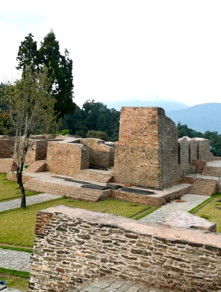
Ruins at Rabdentse
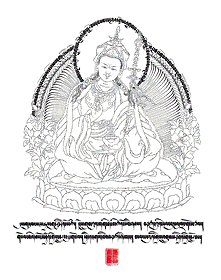
Guru Rinpoche
Mahaguru Padmasambhava
Artwork Courtesy
Jamyang Dorjee Chakrishar
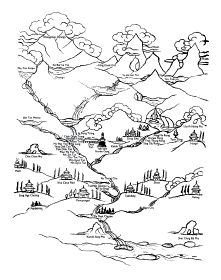
Sacred Sites of West Sikkim
Illustration by CCS
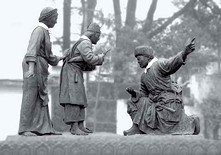
Memorial in Kabi Lungchok
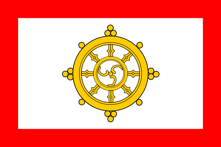
Flag of the erstwhile
Buddhist Kingdom of Sikkim
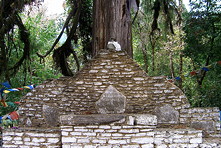
Stone Throne at Norbugang
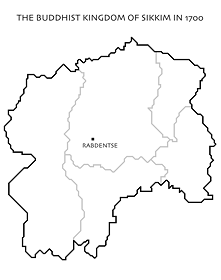
Territory of Sikkim in 1700
Illustration by Chopel Serkhangpa
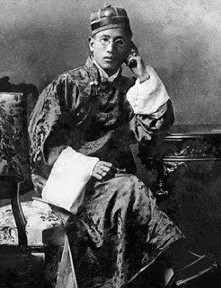
Sidkeong Tulku,
Chogyal with the shortest reign